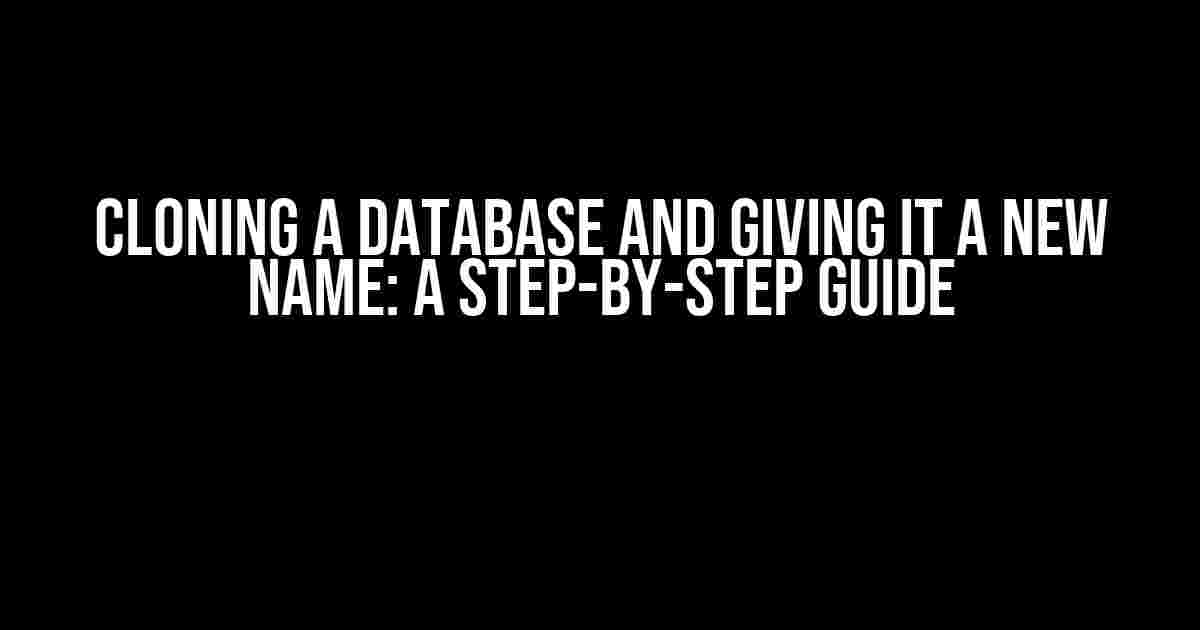Are you tired of working on a live database and worrying about making mistakes? Do you want to create a sandbox environment to test new features or experiment with different database structures? Look no further! Cloning a database and giving it a new name is the perfect solution. In this article, we’ll walk you through the process of creating a duplicate database with a new name, ensuring you can work freely without affecting your live database.
Why Clone a Database?
There are several reasons why cloning a database is essential:
- Sandbox Environment**: A cloned database provides a safe space to test new features, try out different database structures, or experiment with new queries without affecting your live database.
- Backup and Disaster Recovery**: Cloning a database allows you to create a backup of your live database, ensuring you can recover quickly in case of data loss or corruption.
- Development and Testing**: A cloned database enables developers to work on new features or bug fixes without disrupting the live database, ensuring a smooth development process.
- Audit and Compliance**: Cloning a database helps you create an exact replica of your live database, making it easier to conduct audits, perform compliance checks, or meet regulatory requirements.
Preparation is Key
Before you start cloning your database, make sure you have the following:
Cloning a Database: Step-by-Step Instructions
Here’s a step-by-step guide on how to clone a database and give it a new name:
Method 1: Using a Seeder Script
mysql -u username -p password live_database < seeder_script.sqlReplace:
username: Your live database usernamepassword: Your live database passwordlive_database: The name of your live databaseseeder_script.sql: The seeder script file containing the database schema and data
This method uses a seeder script to create an exact replica of your live database. The script will create a new database with the specified name, and import the schema and data from the live database.
Method 2: Using Backup Files
mysqldump -u username -p password live_database > clone_database.sqlReplace:
username: Your live database usernamepassword: Your live database passwordlive_database: The name of your live databaseclone_database.sql: The backup file containing the database schema and data
This method uses the mysqldump command to create a backup file of your live database. You can then use the backup file to create a new database with the specified name.
Method 3: Using a GUI Tool
If you're not comfortable with command-line tools, you can use a graphical user interface (GUI) tool like phpMyAdmin or HeidiSQL to clone your database.
| GUI Tool | Cloning Method |
|---|---|
| phpMyAdmin | Export live database > Import to new database |
| HeidiSQL | Backup live database > Restore to new database |
Rename the Cloned Database
Once you've created the cloned database, you can rename it to your desired name:
RENAME DATABASE clone_database TO new_database_name;Replace:
clone_database: The current name of the cloned databasenew_database_name: The desired name for the cloned database
Best Practices and Troubleshooting
To ensure a successful database clone and rename, follow these best practices:
If you encounter any issues during the cloning process, refer to the following troubleshooting tips:
Conclusion
Cloning a database and giving it a new name is a straightforward process that can save you time and effort in the long run. By following the steps outlined in this article, you can create a duplicate database with a new name, ensuring you have a safe space to test new features, experiment with different database structures, or meet regulatory requirements.
Remember to regularly backup your live database, verify the cloned database, and test it before making any changes. With these best practices and troubleshooting tips, you'll be well on your way to creating a reliable and efficient database cloning process.
Happy cloning!
Frequently Asked Question
Get the scoop on cloning a database and giving it a new name!
What does it mean to clone a database?
Cloning a database means creating an exact copy of the original database, including all its structures, data, and settings. It's like duplicating a master painting - you get an identical twin!
Why would I want to clone a database?
You might want to clone a database to create a testing environment, to migrate data to a new server, or to preserve a snapshot of your database at a specific point in time. It's like taking a snapshot of your database's progress - you can always look back and see how far you've come!
Can I give my cloned database a new name?
Absolutely! You can rename your cloned database to anything you like. This is especially useful if you want to differentiate it from the original database. Just think of it as giving your database a brand new identity - fresh start, new name, new possibilities!
Will cloning a database affect my original database?
Nope! Cloning a database is a non-invasive process that doesn't touch your original database. Think of it as taking a digital photocopy - the original remains untouched, and you get a separate, identical copy.
How do I clone a database?
The cloning process varies depending on your database management system. For example, in MySQL, you can use the mysqldump command, while in PostgreSQL, you can use the pg_dump command. Don't worry, it's easier than it sounds - just follow the instructions, and you'll be cloning like a pro in no time!

